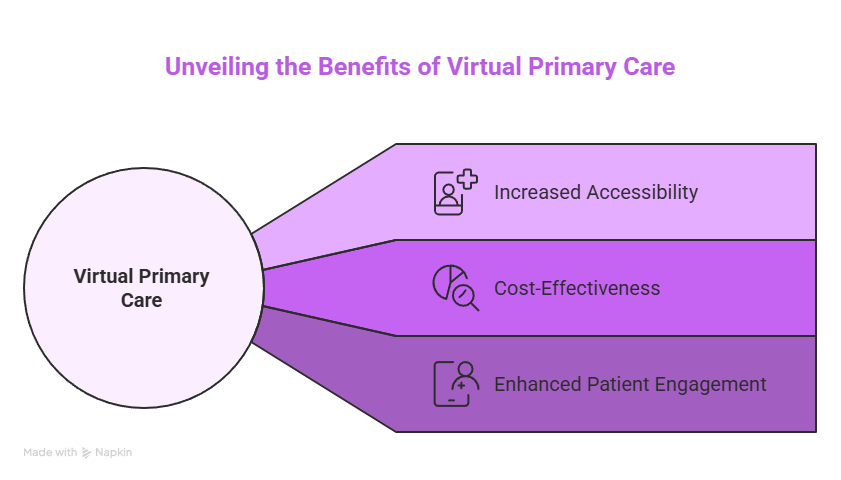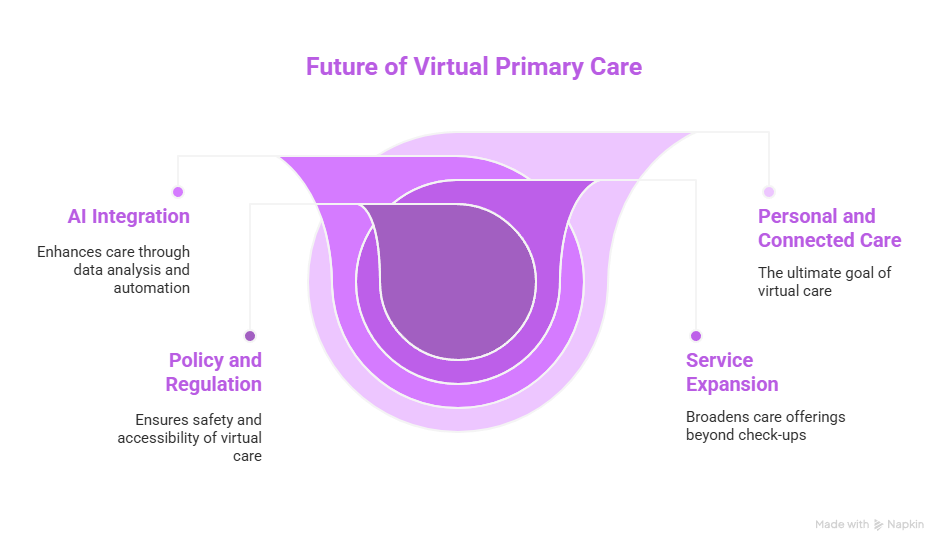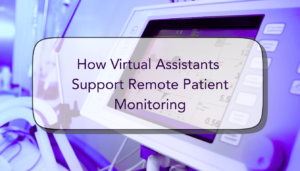The Future of Healthcare: Exploring the Benefits of Virtual Primary Care
04 Jun 2025 By: Vlade Legaspi
Updated

As tech keeps growing, healthcare is changing with it. One big change is the rise of virtual primary care. It makes care easier to reach and improves the whole experience. In this article, we’ll look at its benefits and how it’s shaping the future of care.
Understanding Virtual Primary Care
Virtual primary care means seeing your doctor without leaving home. It helps patients talk to doctors by video, phone, or message. During COVID-19, it became popular because staying home kept people safer. Since then, clinics have quickly added these tools to make care easier and more convenient for everyone.
Defining Virtual Primary Care
Virtual primary care makes seeing a doctor feel easier and more natural. You can chat by video, talk on the phone, or send a message all from home. Whether it’s a check-up, help with a health issue, or just a question, care comes to you. No waiting rooms, no long drives just quick, friendly help when you need it.
For people far from clinics or busy with life, it’s a real lifeline. You don’t have to skip work or travel miles to get care. And with fewer people crowding clinics, doctors can focus more on each patient. Virtual care feels more personal, more relaxed, and puts your health in your hands. Behind the scenes, virtual medical assistant services help ensure this smooth experience by managing scheduling, follow-ups, and patient communication.
The Role of Technology in Virtual Care
Technology makes getting care feel easy and natural. With video visits, quick messages, and online records, you can reach your doctor from your couch. No traffic, no waiting rooms just simple, stress-free care that fits your life. It’s all about making health support feel close, even from far away.
New tools are making it even more helpful. Chatbots can guide you when you’re not sure what’s wrong or help book a visit fast. Smartwatches and fitness trackers let your doctor see how you’re doing day by day. They help spot small issues before they grow. It’s care that feels more connected, more personal, and built around you.
Why Virtual Primary Care Matters

Virtual primary care makes life easier for patients, doctors, and the whole health system. It brings real help and better care to more people. Understanding these advantages can shed light on why this model is likely to become a cornerstone of future healthcare delivery.
Increased Accessibility
Virtual care brings help right to you, no matter where you are. If you live far out, can’t find a ride, or don’t have a nearby clinic, it’s a game changer. You don’t need to dress up, drive miles, or sit in a waiting room. You can talk to your doctor from your couch, in your pajamas, with a cup of tea in hand. It’s care that meets you in your real life.
It’s also there when life feels too full. Maybe the baby’s napping, your body aches, or you’ve got work piling up. You can still check in, ask questions, and feel heard. No need to rearrange your whole day. It’s easy, kind, and made for the way we live now. It’s healthcare that feels like someone’s actually looking out for you.
Virtual care saves you from long waits and delayed help. Instead of waiting weeks, you can often talk to a doctor the same day. That quick response can ease worry and help you feel better faster. If something comes up suddenly, you don’t have to sit and wonder, you can get answers right away, when it really counts.
It also makes staying on top of your health feel simpler. Follow-ups can happen from your home, on your schedule. You don’t need to skip work or find a sitter. A short chat lets your doctor check in, tweak your plan, and make sure things are going well. It’s care that keeps up with you, not the other way around.
Cost-Effectiveness
Virtual care helps your health and your wallet. A quick video chat often costs less than a clinic visit. You save money on gas, parking, and babysitters. You don’t have to leave work early or sit in traffic. And now that more insurance plans cover it, getting care from home is easier and cheaper for more people.
It also gives clinics room to breathe. When fewer folks show up for small issues, doctors can focus more on serious cases. That helps the whole system work better. You still get good care just without the extra cost, stress, or time lost. It’s care that feels easier in every way.
Virtual care helps keep emergency rooms from getting too full. A lot of people head there for things that aren’t true emergencies. But with virtual visits, those issues can be handled from your couch. That means ER staff can focus on people who really need urgent help, and everyone gets seen faster and with less stress.
It also saves clinics money. With fewer people coming in, they spend less on things like space, supplies, and cleaning. That extra money can go into better tools and training, so care keeps getting better. Virtual care doesn’t just help you, it helps the whole system work more smoothly.
Enhanced Patient Engagement
Virtual care feels personal. You can reach out when something’s off, no need to wait or second guess. Just a quick message or call, and you’re heard.
That simple connection means a lot. You feel cared for, not rushed. Over time, it builds trust. It’s not just about fixing problems, it’s knowing someone’s truly there for you.
With virtual care, your health fits into your life, not the other way around. You check your blood pressure, track your sugar, and send it off knowing someone’s paying attention. Those little numbers hold your story, your tired mornings, your better days. And your doctor doesn’t just see data, they see you. That’s how care starts to feel real. Like it belongs to you.
These tools feel like a friend, reminding you to take your meds and showing you simple ways to stay well. You’re not left to figure things out alone. With each tip, you feel more sure, more in control. It’s care that’s kind, steady, and right there with you every day.
What to Keep in Mind

Virtual care makes life easier, but it’s not always enough. Some problems still need a hands-on check. Not everyone has good internet or knows how to use the tech. For some, like older adults or people far from cities, it can feel confusing or out of reach.
Doctors feel the pressure too. They want to give great care but can’t always see the full picture through a screen. Trust and connection take more work. But when both sides stay open and work together, virtual care can still feel real, warm, and helpful.
Technological Barriers
Even with all the new tools, not everyone can use virtual care the same way. Some people don’t have strong internet or a smartphone. Others feel unsure about using apps or video calls. For older adults or those with less income, it can be hard just to get started.
This makes care harder to reach for the people who may need it most. Virtual care has so much promise, but only if it works for everyone. We need to make sure no one gets left behind just because they don’t have the right tech or support.
Doctors and clinics need to notice when tech gets in the way, and help fix it. That could mean offering phone calls instead of video, or walking someone through how to use an app. A bit of kindness and time can make all the difference.
Local groups can be a friendly face in a confusing world. They sit with people, show them how virtual care works, and remind them it’s not so scary. When someone feels supported, they feel braver, stronger. With a little help, anyone no matter their comfort with tech can feel ready to take care of their health.
Keeping Your Health Info Safe
Sharing your health online can feel scary. It’s personal, and you want to know it’s in safe hands. That fear is real, and it matters.
Your doctor should protect that trust like they protect your health. Strong passwords, locked systems, and clear rules help keep your info private. You deserve care that feels safe in every way, not just for your body, but for your peace of mind too.
You have a right to know how your health info is used and to feel safe sharing it. Choosing trusted apps, asking questions, and knowing your rights all help. When you feel in control, care feels more personal and less risky.
Doctors and clinics are doing their part too. They use strong tools to keep your info locked up and safe. And if you learn simple things, like spotting safe sites or using strong passwords, you add another layer of safety. It’s all about working together so care feels both safe and supportive.
Quality of Care
It’s okay to wonder if a screen can offer the same care as a visit in person. Often, it can. A kind voice and someone really listening still matter, even online. But sometimes, you need a doctor to be there to check, to touch, to see what a screen can’t show. Good care isn’t just one way or the other. It’s about giving you what feels right, when you need it most.
Every person is unique, and so is their story. That’s why doctors need to listen with care, to truly understand what feels right for each patient. Sometimes a video chat is enough. Other times, a face to face visit is what’s needed. Often, a mix of both gives the full picture and helps patients feel truly cared for.
To give their best, doctors also need time to learn and grow. New tools and ways to connect keep coming, and staying updated helps them use these tools well. When doctors keep learning, patients get better care. It’s how we build a system that feels personal, modern, and truly centered around each person.
Looking Ahead: The Future of Virtual Primary Care

Virtual care is growing fast, and big changes are coming. New tools and fresh ideas will shape how we see doctors and care for ourselves. By keeping an eye on these changes, we can better understand how care will feel in the years ahead, more personal, more connected, and easier to reach.
Bringing AI into Care
AI is set to make virtual care even smarter. It can spot patterns in your health data and warn doctors before problems grow. That means faster, more helpful care.
It also helps guide you to the right care. If you share symptoms, AI can help sort out what’s needed, saving time and giving you answers quicker. It’s like having a quiet helper in the background, always looking out for you and making sure you’re okay.
AI chatbots take care of the little things like, scheduling visits, answering quick questions, or sending gentle reminders. That way, doctors can focus more on the people who need their time and heart the most.
These smart tools keep getting better, too. They learn from data to give more personal tips and help that fits your health. It makes care faster, easier, and more focused on you.
Expansion of Services
As virtual care becomes more common, it’s growing beyond just check-ups. Soon, you could talk to a therapist, get help with your diet, or do guided stretches, all from home.
It’s care that looks at the whole you, not just one part. Whether it’s your body, your mood, or your daily habits, there’s support just a click away. It’s about feeling better in every part of life.
Wearable tech and health apps help you stay on top of your health from home. They track how you feel and send updates straight to your doctor. If something’s off, your doctor can step in fast. This can help you stay out of the hospital and save money too.
By sharing your health data, you stay involved in your care. You see what works and what doesn’t. Your doctor gets a fuller picture and gives better advice. It feels more like a team effort. You stay healthier and feel more supported every step of the way.
Policy and Regulation Changes
The fast rise of virtual primary care has sparked talks about changing health policies. Many governments and healthcare groups now see that current rules don’t fit the way telehealth works. They’re starting to look at new laws and guidelines to support this shift. Key concerns include how doctors get paid for online visits, who can treat patients across state lines, and how to make sure virtual care stays safe and effective.
These updates matter because they shape how easily people can get care from home. If done well, new policies could help more people see a doctor without leaving the house. Clear rules can also give doctors more confidence in offering virtual care. As telehealth keeps growing, smart changes will help patients get the right care, wherever they are.
As rules around virtual care change, they’ll help shape how we get care in the future. These updates can make it easier to see a doctor from home, while still making sure the care is safe and reliable. Policymakers have to support new ideas but also protect what matters most is our health and safety.
As more of our health moves online, keeping personal info safe becomes even more important. People want to know their data won’t fall into the wrong hands. When they feel their info is secure, they’re more likely to try virtual care. Building that trust is key to making this way of getting care work for everyone.
Trending Now
This article gently paints a picture of a new kind of care, where AI and telemedicine quietly work in the background, helping things run smoother. AI can spot changes in your health, help doctors understand your story, and offer care that fits your life. With chatbots and home tools, support can show up right when you need it, without the stress of waiting rooms or long drives.
Still, the heart of the message is clear: care is, and always should be, deeply human. A screen can’t see the tears in your eyes or hear the pause in your voice. AI can guide and support, but it can’t replace the warmth of a doctor who knows your name and truly cares. Real healing comes from connection and the future of care needs both smart tools and kind hearts.
As you embrace the future of healthcare with virtual primary care, ensure your practice is supported by the best in customer service and back-office management. HelpSquad Health is here to provide you with dedicated virtual assistants and a 24/7 customer service team, tailored to meet the demands of the healthcare industry. Our bilingual agents are ready to enhance your efficiency and patient engagement, starting at just $9 per hour. Start your trial today and take the first step towards a streamlined, patient-centered healthcare experience with HelpSquad Health.


